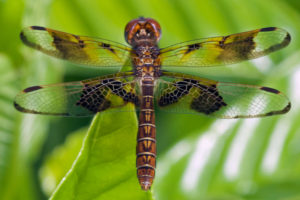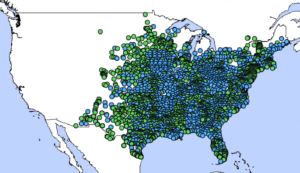Early in November, the weather turned nice, so I went outside with my camera. Found a few bees, a couple of butterflies, and, just as I was rounding the corner out front I saw what looked like a wasp out of the corner of my eye. Turned out to be one of the smallest dragonflies in the area (and in the country), an excellent wasp mimic, the Eastern Amberwing (Perithemis tenera):

Once you get a good look at the creature, you can tell that it’s not a wasp. However, its small size and its amber color pattern sure can fool those who catch only a fleeting glimpse. Dennis Paulson’s Dragonflies and Damselflies of the East says this about it:
Both sexes, especially females, may be effective wasp mimics. Wing-waving when perched seems to enhance this similarity, and female in flight, with dark wing bases and spindle-shaped abdomen, is sufficiently wasplike to fool an odonate enthusiast and presumably an insect-eating bird.
You can see the swollen abdomen in the photo above; the back half of the tail is much wider than the middle portion, contributing to the “wasplike waist” look of this species.
It’s a fairly widespread dragonfly, as you can see from the sightings reported in Odonata Central:

Etymology
The genus name, Perithemis, means “near Themis,” which presumably refers to its assumed close relationship to other libellulid species (the dragonflies known as Skimmers). Themis is Greek for “order,” and it’s an old name for a dragonfly genus.
The species name, tenera, means fragile or delicate.
References
Paulson, D. R. and S. W. Dunkle. 2016. Checklist of North American Odonata, Including English Name, Etymology, Type Locality, and Distribution. 2016 edition.
Paulson, D. R. 2011. Dragonflies and Damselflies of the East. Princeton: Princeton UP.
